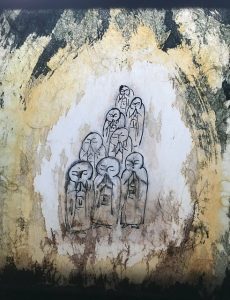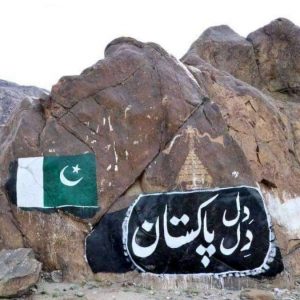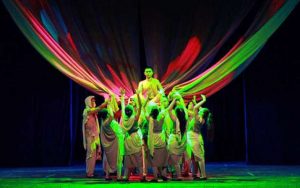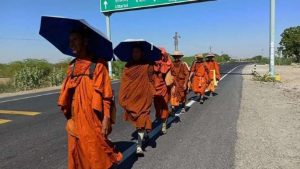Among Abu Dhabi Louvre’s stunning collections is the intersection of two great spiritual civilizations: those of the Egyptians and the Buddhists. They are two venerable bodies of spirituality, history, and culture that I have been engaging with since childhood. Their encounter at the cultural and artistic crown of the United Arab Emirates is the result of historical convergences that were physically embodied in the Silk Routes that crisscrossed Eurasia. Under the auspices of the UAE’s Sheik Mohammed bin Rashid Al Maktoum, leader of the emirate federation since 2006, the 2007 partnership between Abu Dhabi and the government of France introduced a new expression of the universal museum, with the vision of presenting Abu Dhabi and the UAE as a key cultural area in the world, and tell the story of the Arab world’s unique perspective on universality and cultural exchange. Louvre Abu Dhabi’s construction was completed in 2017.
Having visited the museum in early August, I later asked Manuel Rabaté, director of Louvre Abu Dhabi, what some of his favorite pieces were. “With an ever-growing permanent collection like ours that spans 12,000 years of history and humanity, which is complemented by our chronothematic approach and loans by our partners, this is a question I could go on and on for,” he said. “One remarkable example among our impressive artworks is the sculpture Seated Avalokiteshvara (Guanyin) dating from the years 1050–1150. It portrays Guanyin, a revered Buddhist divinity bodhisattva known for embodying compassion and believed to attentively listen and respond to human grievances. In this sculpture, Guanyin is depicted in a common ‘royal ease’ posture, with one leg bent and the other resting gracefully on the pedestal. His right hand is raised in a gesture symbolising fearlessness.”
“With Guanyin represented in various forms this sculpture is just one of the many possible representations of this divinity. Another piece worth mentioning is the Monumental Lion. Associated with imperial authority, lions are one of the most universal symbols of courage, majesty, strength, and power,” Rabaté continued. “Created at the meeting point of the East and the West, the Monumental Lion is regarded as a product of Islamic Spain but could also be the work of itinerant artists in the part of Italy under Norman rule. Comparable to the Andalusian Pisa Griffin as a piece of animal statuary, the Monumental Lion displays a combination of accentuated stylisation and Arabic inscriptions that encapsulates the attraction and the role of the arts of Islam in Sicily, North Africa, and Spain in the late 11th and early 12th century, one of the most creative periods in their history.”
Inching further to the West, Rabaté highlighted a masterpiece by an iconic man of the Renaissance: “Another notable piece we have is St John the Baptist, by the Italian master Leonardo da Vinci, which is currently on loan from Musée du Louvre. It is an important piece for people to see as Da Vinci was a universal genius, a polymath, and an icon of artistry. He was open to the world and interacted with it through his art. This ties in closely with the museum’s longstanding mission of building cultural connections through art, by showcasing our commonalities that transcend time, space, and geographies.”
Louvre Abu Dhabi takes its name from the original Musée du Louvre, but in my opinion, Louvre Paris can feel a bit “siloed” in its presentation of the past. It goes the traditional route of presenting Roman antiquities in—unsurprisingly—the Roman Antiquities gallery, while an entire counterpart for the Arts of Africa, Asia, Oceania and the Americas seemingly implies that this is one section, disconnected from the Roman or Near Eastern and Egyptian items. Louvre Abu Dhabi takes a different approach to the museology experience. It “flattens” out the siloed civilizations and presents them as part of one universal story. As the website notes, “The galleries are not separated by geography but set in chronological order. The aim is to encourage respect, curiosity, learning and self-reflection.” (Louvre Abu Dhabi)
Rabaté, himself a pioneer at the forefront of the art world, is deeply familiar with this vision. “As the first universal museum in the Arab world, Louvre Abu Dhabi is a shining testament to the dynamic nature of the region and its vibrant multicultural heritage. It is a museum that transports you through time from prehistory to the modern world; where in its 12 chapters, you explore the birth of the first villages; universal religions; cosmography; the magnificence of the royal court; and the modern world,” he said, adding in regard to the architecture: “I also believe that Louvre Abu Dhabi in itself is a sight to behold for local, regional and international visitors. We often see people flocking to the museum to see the 7,500 stars that make up our iconic ‘floating’ dome. Designed by award-winning architect Jean Nouvel, the complex geometric structure is inspired by the cupola—an intentional ode to the museum’s roots in the region and its universality.”
The modern UAE lies at the crossroads of ancient civilizations and the Islamic world—with Egypt not too far away in the west and Pakistan and India to the east. Accordingly, Louvre Abu Dhabi’s galleries move beyond individual civilizations, periods, or locations and focus on common stories of creativity and innovation. One of these dimensions is “universal religions” (Gallery 4), which is completely unique in the Arab world as not just a curatorial strategy, but also as a philosophy of history. It speaks to the open-mindedness of Louvre Abu Dhabi’s supporters, and to their enthusiasm about building on the theme of connection: between religions, between cultures, and at a slightly meta level, between different institutions, curating organizations, and lenders.
As Rabaté notes, several upcoming events will bring this connective priority and power of the museum into the foreground. “This September, we will be launching our latest exhibition Letters of Light, in partnership with Bibliothèque National de France, which will feature a diversity of artworks including the Blue Quran and an exceptional work by contemporary Saudi artist, Muhannad Shono. Later this year, we will unveil our exhibition with Cartier, which is co-organised with the Musée des Arts Décoratifs, the Musée du Louvre, and France Muséums,” he also noted.
“The exhibition will highlight the influence of the Islamic arts on Cartier’s design from the beginning of the 20th century to the present day. Early next year, we will launch Fables from East and West: from Kalila wa Dimna to the Fables of La Fontaine, in partnership with Bibliothèque nationale de France and France Muséums. Fables from East and West will examine the roots and evolution of this genre through a showcase of illustrated manuscripts, paintings, contemporary works and more.”
The “Silk Roads” is my personal favorite theme about human and historical connection. Situated in Gallery 5—formally called Asian Trade Routes—the very nature of the Silk Routes’ function is tied to the museum’s concept of universal religions. They were the forebears to the confluence of technology, culture, and economics that characterized the modern period and have continued with 21st century globalization and digital tech. Through museology, the union of religion, technology, and trade becomes apparent and celebrated. As the lead-in panel to Gallery 5 describes:
The expansion of universal religions occurred in parallel with the establishment of vast networks of exchange between continents [my emphasis]. In Asia in the 7th century, China became the main actor in these exchanges and a major hub for innovation. . . . China passed most of its inventions to the Arab-Muslim world along the land and sea routes used in the silk trade.
The Islamic civilisation lay at the heart of this thriving trade network linking Asia, Europe and Africa. From the 8th to 10th century, Baghdad witnesses a golden age of the arts and sciences. The caravan routes taken by merchants crossed the paths followed by pilgrims [my emphasis], and promoted the spread of new modes of thought.
(Louvre Abu Dhabi)
Aside from the director’s pick of Guanyin, I found one of the most beautiful displays to be the Bodhisattva—a towering specimen of a princely celestial, gazing down on his viewers with a serene and mild smile. He is paired up with the Orator, a dour Roman statesman that was carved at around a similar time period to the bodhisattva. The bodhisattva was carved out of schist sometime around 100–300 CE, while the orator was carved from marble during a narrower time frame, 100–150 CE.
The Bodhisattva and the Orator are featured on Louvre Abu Dhabi’s website, and the homepage lists a striking set of online priorities. I asked the director about what his team’s curatorial strategy for online content might be, and he noted: “Expanding our online offering is one of Louvre Abu Dhabi’s primary focus areas. By exploring new platforms to communicate art, we can reach out to a variety of audiences—including audiences from across the globe who may not have the chance to visit our museum just yet.
The Pulse of Time was a part of this strategy—it is a 40-minute film where Saoud Al Kaabi (City of Life, The Platform), Charles Dance (Game of Thrones), and Irène Jacob (Three Colours: Red) tell the story of Louvre Abu Dhabi’s masterpieces in Arabic, English, and French. It was an original production of Louvre Abu Dhabi supported by Alexandre Plank, Radio Producer for the French National Radio channel France Culture, and Antoine Richard on the direction and sound design.”
Rabaté also said that the museum launched We are not alone, a futuristic 20-minute audio walk created by Soundwalk Collective. “The intention is to explore the meaning of Louvre Abu Dhabi in various environments including a post-human galaxy. It was interpreted by Willem Dafoe in English, Charlotte Gainsbourg in French, Hussain Al Jassmi in Arabic, and Zhou Dongyu in Chinese. Other collaborators include Nina Kraviz, Wim Wenders, and Jean Nouvel.” With collaboration in consideration, Rabaté added: “As a museum that believes in the power and potential of collaboration, we will endeavor to partner with other cultural institutions and like-minded entities around the world to create new exhibitions and events. This is underscored by our strong relationship with France Museums, Musée du Louvre, and our other partner museums, who have helped us deliver landmark exhibitions.”
Louvre Abu Dhabi’s programming and outreach team have also worked hard to provide an accessible and inclusive experience. In this regard, they have launched several initiatives like an extensive multimedia guide of the collection, which is available on the museum’s app. There is also the first children’s podcast in Arabic for kids, dedicated to Louvre Abu Dhabi’s artworks. “The stories curated for the children’s podcast were written by Emirati authors reinforcing our commitment to empowering the local and regional art community,” said Rabaté. “We are also proud that alongside our latest exhibition Picturing the Cosmos, we organised an online call to space with our partner the Mohammed bin Rashid Space Centre, to speak to Emirati astronaut Sultan Al Neyadi. Community is at the heart of all that we do at Louvre Abu Dhabi, and we are proud to offer and seek new ways of communication to further our outreach.”
One of the most obvious components of this outreach is, of course, the community of artists in the UAE and beyond. Rabaté has also factored this into his plans for the museum. “Our commitment to support artists in the region and beyond is paramount, and we are constantly looking at ways to empower the artistic community by providing them with a platform to showcase their expertise. This is made evident through our annual Art Here exhibition and the Richard Mille Art Prize, which is done in partnership with Swiss luxury watch-maker Richard Mille.”
Looking back on the theme of universal experience, I—like many others—felt like more than just visitors: we were witnesses to our own history, reflected through the museum and its artifacts; we were co-participants of the curatorial experience in a lesser but very special sense. Rabaté wants to take this sense of shared destiny further, into one of shared activity. “We are also working to enhance the visitor experience by encouraging audiences to interact with the art and become participants in the exhibitions, and we remain keen to expand our reach and attract a diversity of audiences, from youth to the senior community. Take our University Takeover the Museum series, which invites university students and alumni in the UAE to interact and respond to a theme and develop concepts which museum visitors can interact with.”
Louvre Abu Dhabi is the representative cultural diamond amid a literal desert, glimmering and bright white. Abu Dhabi’s cultural diamond represents a forward-looking vision of what the country can be: a shining artistic city for all to converge on. So far, it is working and audiences are growing. Rabaté has helped to build the institution into a world-class establishment attracting the very best from around the globe. As he said in a concluding remark:
“Our mission remains consistent: through our collection and programming, we open eyes to the universal creativity of humankind, open hearts to stories of cultural connections and open minds to new perspectives on our place in the world. Our vision is to constantly build an inspiring, participatory museum platform for encounter and exchange and want Louvre Abu Dhabi to play a leading role, both in Abu Dhabi and the world, for promoting cultural dialogue, re-thinking art history, and creating innovative and sustainable museum practices.”
See more
Art from Home: Stories of Cultural Connections (Louvre Abu Dhabi)
Seated Avalokiteshvara (Guanyin) (Louvre Abu Dhabi)
Related posts from BDG’s Tea House Blog
Diamond in the Desert: The Dharma and the UAE’s House of Universal Truth
Diamond in the Desert: Buddhism in the United Arab Emirates






















